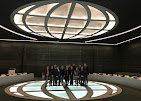ATELIER KOLLER - competition Hôtel de ville Gembloux/BE
 |
| View from the green roof of the supermarket to the Hôtel de ville |
Hôtel de ville Gembloux
The Belgium town of Gembloux is impeded in a city network between Brussels, Leuven, Namur and Charleroi, with all cities lying within a range of 45 km. In order to strengthen the city's position in this area our study proposed to re-qualify its city centre around the new Hôtel de Ville. We emphazise the urban qualities of this Wallonian city by creating an urban park, public plazas and paths to link important points in the centre.
 |
| Site plan |
Imprint
In our vision the new Hôtel de Ville and its surroundings offer space for creation and re-creation and for the different communication, education and social networks already in place in this historical and charming medium-sized city. The simple form of the building, its straight position towards the Château du Bailli, its location on a plateau and the adjacent park are all factors that will make the Hôtel de Ville a new imprint of Gembloux.
In our vision the new Hôtel de Ville and its surroundings offer space for creation and re-creation and for the different communication, education and social networks already in place in this historical and charming medium-sized city. The simple form of the building, its straight position towards the Château du Bailli, its location on a plateau and the adjacent park are all factors that will make the Hôtel de Ville a new imprint of Gembloux.
Centrality
The design of the Hotel de Ville, the Place de l’Hôtel de Ville, the Parc d’Epinal, the parking, the supermarket and the Musée d’Histoire creates functional, physical and visual connections to the surrounding plazas, schools, universities, shopping areas and historical monuments. This connectivity is the first step to regenerate the city centre, to create a new urbanity and to improve the centrality of Gembloux.
 |
| Haptic qualities of the urban park |
Locus
We attach the design of the new Hôtel de Ville strongly to its locus. Its implementation in the Parc d’Epinal gives the office building its particular character and vice versa. The integration of the park into the design of the city hall helps create a new meeting place for all socio-economic classes. The Parc d’Epinal gains through the position, orientation and aesthetical characteristics of the buildings.
Functions
The Hôtel de Ville is going to accommodate administrative, representative, educational, re-creative and technical functions. Hence, we include in our proposition the park, the existing walls, the Château du Bailli house, the zones at the bottom of the hill, next to the Place de l’Hôtel de Ville and the inner court of the adjusted housing block.
The Hôtel de Ville is going to accommodate administrative, representative, educational, re-creative and technical functions. Hence, we include in our proposition the park, the existing walls, the Château du Bailli house, the zones at the bottom of the hill, next to the Place de l’Hôtel de Ville and the inner court of the adjusted housing block.
Accessibility
The building is accessible to different users during different times of the day. The development of the complex from the Place de l’Hotel de Ville to the Rue Gustave Docq follows its topographical situation, creating different degrees of public and urban spaces. Park visitors, city employees, shoppers at the supermarket as well as visitors of the city centre and the historical museum have the possibility to enter the site on various levels, by foot, bicycle or car.
 |
| View of he upper plaza |
Dialog
The new building does not compete with the Château du Bailli but rather complements it. The balconies and balustrades around the atrium of the complex can be understood as the introverted form of the façade of the existing Château. The upper plaza creates the entrance to both buildings and visualises the dialog between past and present. As the size of the new Hôtel de ville is more important than the one of the Château du Bailli it is sunk one floor deep into the ground.
 |
| General section with the atrium in the centre of the building |
Openness
The landscape offices with dedicated meeting rooms and offices for higher confidentiality form an open plaza where employees meet the visitors of the city hall. The circulation is organized around a central atrium, which also brings natural light into the depth of the building. It equally allows the regulation of the interior climate. The atrium opens up views within the building, from level to level and across work spaces onto the surroundings of the building. This way visitors and employees can overlook the park, historical monuments and onto the city centre of Gembloux.
 |
| View to the Château du Bailli from the new Place de l’Hotel de Ville |
Materials
The use of beige stone for the building exterior and the pavements in the park reflects the numerous surfaces and materials found in the city. The bright colour of the stone combined with the green of the surrounding nature underlines the special character of this public building and the urban park. Daylight enters throug large glas winows in order to lighten up the working places and to reduce the use of artificial light. White dominates the inside of the building to underline the generosity of the space, while the massive wooden railings refer to rural elements found in the city.
client: City of Gembloux, Belgium (www.gembloux.be).
architects: Darío FERNÁNDEZ PLAZA, Yaron TAM, Atelier Koller (www.atelierkoller.com).
competition: March 2009 – June 2009






